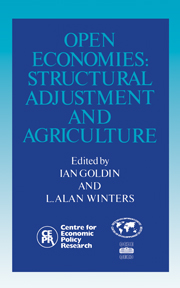Book contents
- Frontmatter
- Contents
- List of figures
- List of tables
- Preface
- Acknowledgements
- List of conference participants
- 1 Introduction: from macro to maize
- Part One Open economy analysis
- Part Two The small country assumption and trade reform
- Part Three Risk and adjustment
- Part Four Government's role
- 11 Infrastructure, relative prices and agricultural adjustment
- Discussion
- 12 Structural factors and tax revenue in developing countries: a decade of evidence
- Discussion
- 13 International dimensions of the political economy of distortionary price and trade policies
- Discussion
- Index
11 - Infrastructure, relative prices and agricultural adjustment
from Part Four - Government's role
Published online by Cambridge University Press: 04 August 2010
- Frontmatter
- Contents
- List of figures
- List of tables
- Preface
- Acknowledgements
- List of conference participants
- 1 Introduction: from macro to maize
- Part One Open economy analysis
- Part Two The small country assumption and trade reform
- Part Three Risk and adjustment
- Part Four Government's role
- 11 Infrastructure, relative prices and agricultural adjustment
- Discussion
- 12 Structural factors and tax revenue in developing countries: a decade of evidence
- Discussion
- 13 International dimensions of the political economy of distortionary price and trade policies
- Discussion
- Index
Summary
Introduction
Contrary to initial optimistic expectations, adjustment by developing countries to the new international economic environment in the wake of the debt crisis has typically proved to be a lengthy and taxing process. As a matter of fact, since 1982 developing countries have been forced to transfer a sizeable share of domestic resources to foreign creditors in order to service their external debt. Under these circumstances, it soon became clear that exclusive reliance on aggregate demand policy was totally inadequate to cope with the economic emergency. For the adjustment effort to be sustainable, aggregate demand management had to be supplemented by supply-enhancing measures. This fact has been fully recognised by international organisations like the World Bank and the International Monetary Fund (IMF). It has prompted these organisations to supplement their lending programmes with policy loans aimed at introducing far-reaching economic reforms in developing countries’ economies with a view of enhancing the efficiency in resource use and improving their long-run growth perspectives.
The agricultural sector was bound to play a major role in this context for several reasons. First, it still represents a substantial component of aggregate domestic production: supply response in agriculture will always be a crucial factor in determining the overall response of the economy to changing economic incentives. Second, there is widespread agreement among both economists and policy makers that previous trade and sectoral policies have discriminated against agriculture. Redressing such a bias represents an indisputable priority on the structural reform agenda. It is not altogether surprising, therefore, to find that agricultural reform was included as a key element in the great majority of structural adjustment programmes supported by the World Bank.
- Type
- Chapter
- Information
- Open EconomiesStructural Adjustment and Agriculture, pp. 245 - 262Publisher: Cambridge University PressPrint publication year: 1992
- 2
- Cited by



